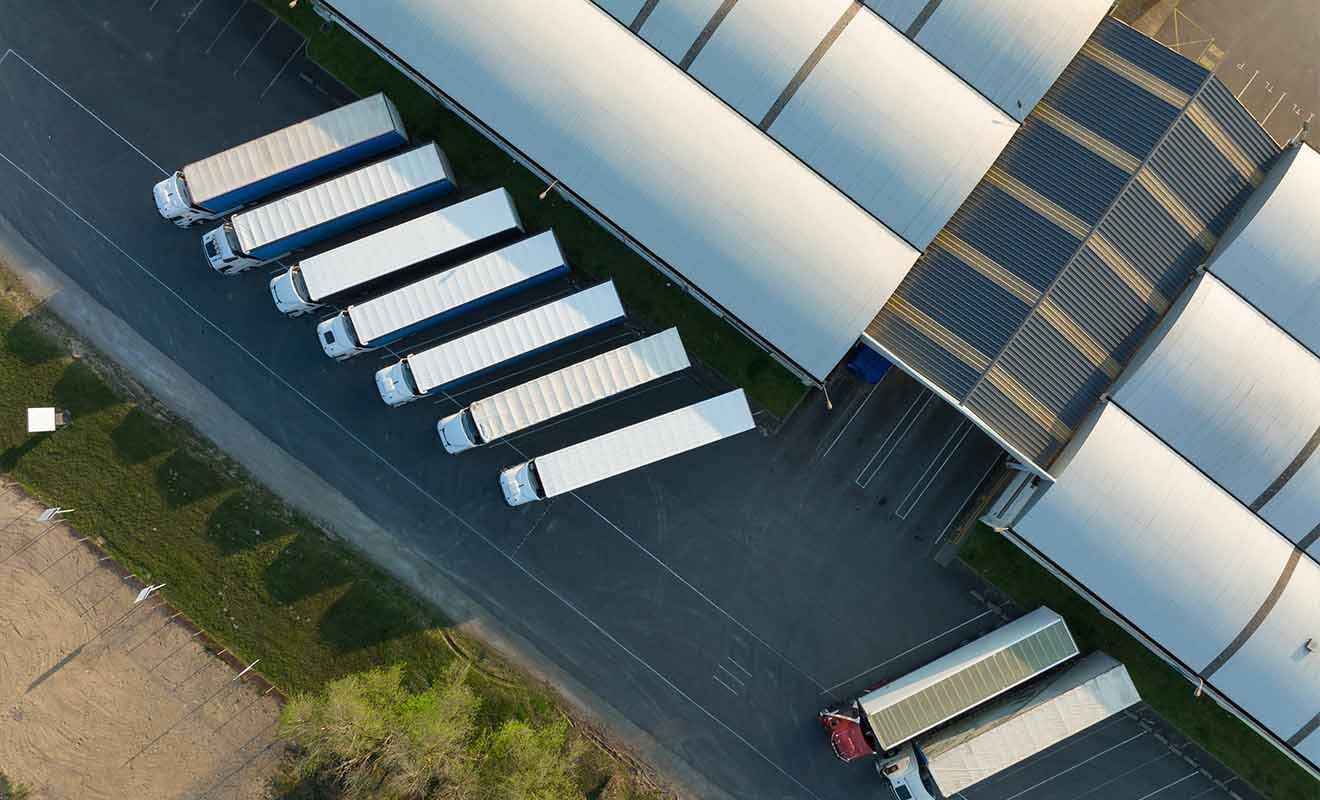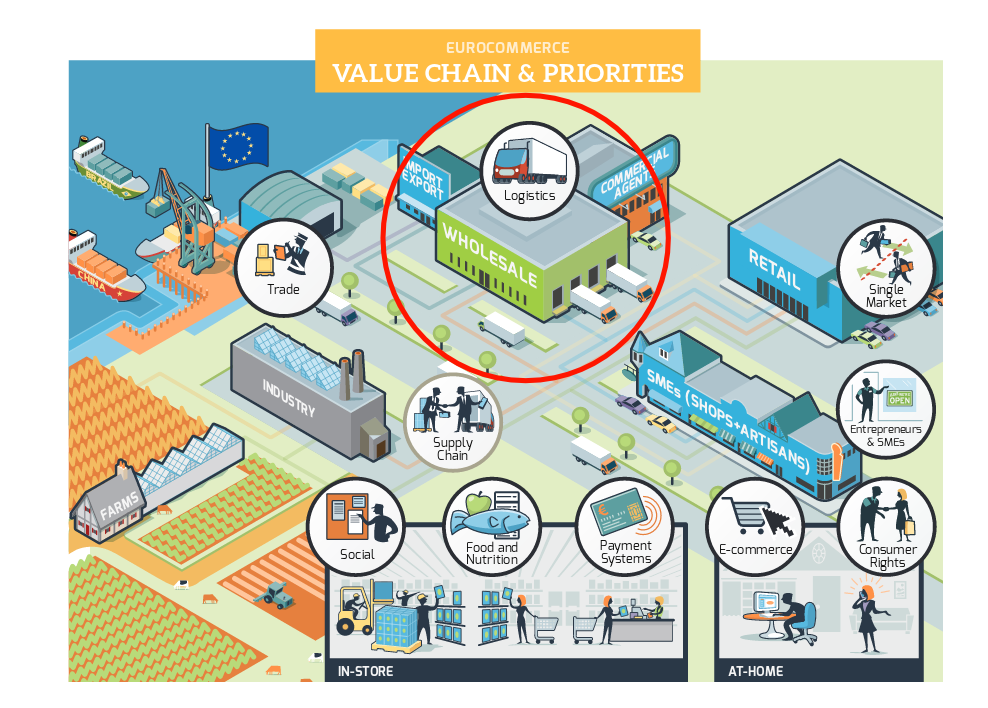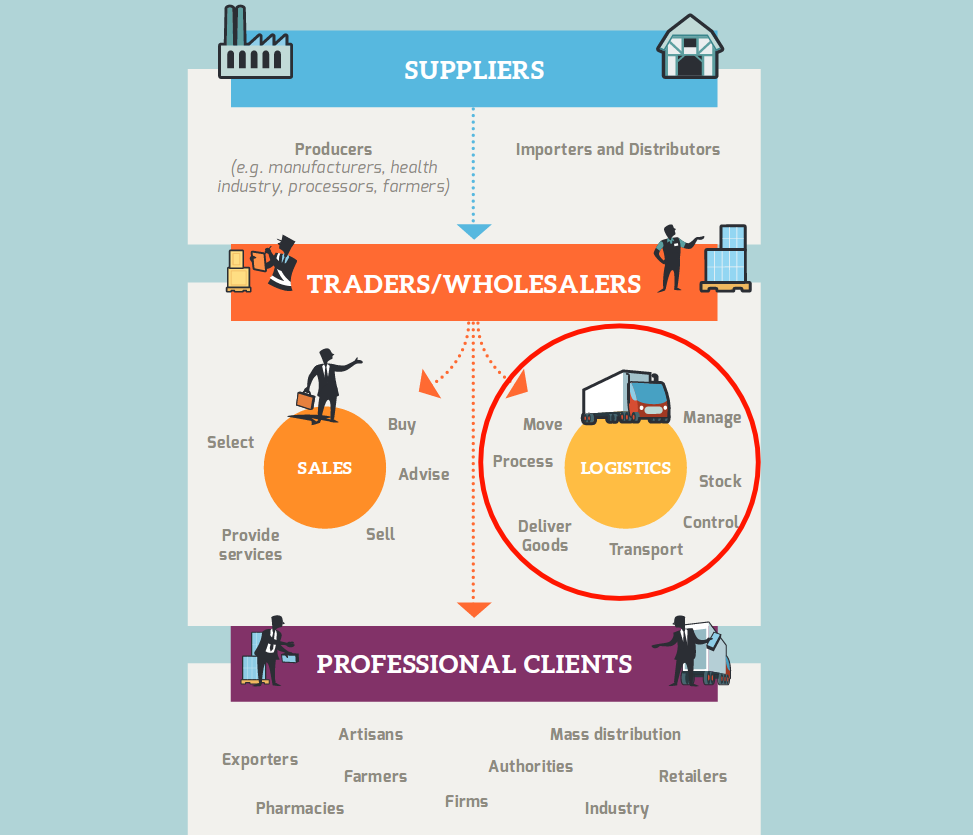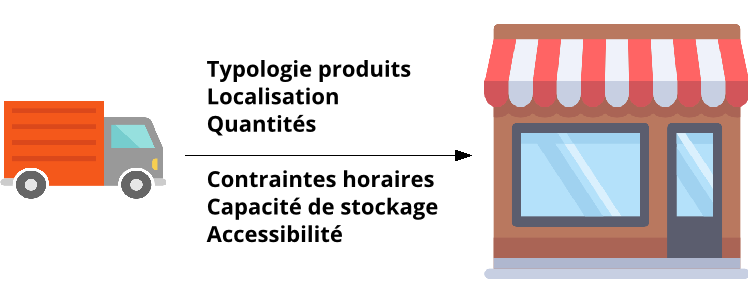Wholesale Trade : problems and challenges of deliveries

Translation and summary of the CGI study: “the wholesaler, a key player in urban logistics”
The Confédération du Commerce de Gros et International (Confederation of Commerce of Wholesale and International) (1) recently published a study in french (2) to better know practices and specificities of wholesalers regarding deliveries”
Wholesalers are professionals which sell goods to artisans, retailers and manufacturers. They are a major business engine in Europe with in 2012 (3) :
- 1.8 m companies in Europe, a share of 8.2% in the total of non-financial business economy
- 10.4 m jobs
- and 5.7 tn
Wholesalers have to deal with several fields such as :
- Agriculture and food: food safety, food waste, marketing standards, traceability, official controls
- Environment and logistics: energy efficiency, product footprints, transport policy
- Internal market: Antitrust & competition law, cohesion, European norms, late payments, product safety, VTA
- International trade : customs, free trade, sanitary and phytosanitary standard
- Supply chain: trading practices
 credit : EuroCommerce, WHOLESALE JOB ENGINE AT THE CENTRE OF EUROPE S ECONOMY
credit : EuroCommerce, WHOLESALE JOB ENGINE AT THE CENTRE OF EUROPE S ECONOMY
In this commerce value chain in the EU we will particularly be interested by products delivery which is a key part of wholesalers logistics activities.
Logistics is now taken very seriously by political and economic entities such us European Union with its 2020 Horizon Research and Innovation Programme. For instance from this program we can see project be launched such as SELIS (Shared European Logistics Intelligent Information Space).
The CGI study provides important insights about urban goods delivery by wholesalers. You can find below its translation and summary
 credit : EuroCommerce, WHOLESALE JOB ENGINE AT THE CENTRE OF EUROPE’S ECONOMY
credit : EuroCommerce, WHOLESALE JOB ENGINE AT THE CENTRE OF EUROPE’S ECONOMY
Wholesalers play a predominant role in our daily lives. Often performed early in the morning, delivery operations are not well known from consumers. However, hundred million of vehicles across the world daily supply pharmacies, bars and restaurants, canteens, bakeries, florists, fish shop, small shops, building sites …
“After sourcing from different suppliers at local, national or international level, wholesalers store goods and deliver daily food and non-food products of the economic framework. As soon as they are needed and in the right quantities, they deliver the products their customers needed.”
The problems of wholesaler’s routes
“… Short deadlines, gradually regarding the needs and in the required quantities…” These requirements, which can be called constraints, are numerous and complicate route planning by logistics managers.

To these multiple constraints, logistics managers must provide relevant qualitative and economic answers.
| Constraints | Answers |
| Poducts types: fragile products, voluminous, fresh, frozen | Equipment: choice of vehicles type and size: light vehicle, truck vehicles, controlled temperature vehicle … |
| Location : urban dense, urban, inter-urban | Equipment: vehicle choice size. Organization: geographical sectorization or mutualisation |
| Delivrable quantities | Equipment: vehicle choice size, fleet size. Organization: respect legislaion (ex: vehicle payload), seasonal management |
| The storage capacity of the delivery destinations | Organization: frequencies delivery management, balancing of the weekly workload |
| Customer time window constraints | Organization: strict time respect or flexibility, scheduling routes and route optimization |
| Accessibility: parking, discharging etc. | Equipment: handling means: vehicle with hatch, roller, pallet truck |
In addition to these almost daily constraints, there are general problems which also have deep impact on companies.
The new influential trends
- The urban density
“Problems related to urban logistics have gradually emerged over the past twenty years, correlated with social and urban changes. The urban density is increasing year to year”.
“This density is not necessarily correlated with the economic activities presence in urban areas, particulary in the downtown. (…) This leads to create replenishment systems with drawn flow and to multiply the transport to answer to this replenishment”.
- An increasingly volatile customer demand
“(…) The consumer demand evolution, which has access to a wide range of distribution channels (retail, distribution, mail-order sale), and to which merchants offer as wide a range of products as possible in order to position themselves in an exacerbated competitive system”.
“The innovation, both in the product and in the commercial relationship (orders access, advice on use, customization…), accentuates the pressure on activities, even more in downtown.”
- Environmental impacts
International political bodies are structuring to impose standards and solutions that are energy-efficient. For this reason, measures that are both binding and incentives have been make for several years.
“Businesses awareness, especially wholesalers, about their environmental impacts in their organization choices converges with economic goals.”
“Companies engage in citizen initiatives, but they always remain players who have to make positive results to survive. They are aware that the environment is increasingly interfering with competition and some are developing decisively offensive tools (“clean” vehicles, packaging management, displaying carbon footprint …)."
“The hardening of the rules defining the permissible levels of air pollution or noise, supports the creation of systems that allow flows articulation in the city. “
To reduce environmental footprint and for more service, some wholesalers are also working to recover the waste. This further complicates the route planning which have now to mix pickup and delivery.
Delivery towards the digitization
As logistics is wholesalers key activity, they are particularly sensitive to the logitsics cost structure stability. In fact, we notice that transportation costs remain the dominant cost as they represent half of the logistic costs and they are not the only ones. Wholesalers are aware that to manage such a level of complexity in their costs structure they have to digitalize their practices.
“These costs are closely related to the variables affecting logistical resources (oil prices, interest rates, labor costs), also to the supply chains performance and efficiency and the information flows control to drive these channels, to “supply the right product, at the right place at the right time and at the best cost”.
“Considering goals and constraints, wholesalers have to invest in “optimization information systems” (management of an increasingly rare space, warehouse management, traceability, route optimization, loading vehicles optimization), anticipation and piloting, which we will find transversaly to the activities.”
“Logistics, in the thick of the wholesale distributor business, is strongly impacted by the new digital tools. These are flows accelerators (of information and products) which make it possible to answer to a demand that constantly both quantitatively and qualitatively changes.”
“These information systems must allow to anticipate (planning), to organize (management systems), to pilot and to follow (traceability, dashboards, KPI). (…) Technical and technological innovations affect: Vehicles (improvement of engines, reduction of consumption, geo-localization, “clean” vehicles, etc.).”
“(…) The flows management and the city organization are now at the dawn of profound transformations due to the logisitics digital transition and the city ecological transition. “
Compliance with regulations, improvement of service quality, reduction of costs, reduction of CO2 emissions … The deliveries digitization also improves the working conditions of both planners and deliverers:
- Automated planning of routes, therefore less tedious work for planners
- Better visibility, so less stress in the face of hazards for planners
- Shorter routes, less loaded and more balanced, with less pain for the deliverers
In fact, the information systems dedicated to logistics and route optimization especially contribute to the HR security of deliveries and of the working conditions improvment; working conditions which are under more regulation by the public authorities.
In summary, “the professional can not ignore these developments and must adapt itself to the future framework in which he will have to be positioned".
(1) The CGI is the professional organization representative of the entire trade of the 56 federations of the wholesale branch in France
(2) Download the study (french)
(3) Wholesale, Job Engine at the center of Europe’s economy, EuroCommerce, 2013 (english)
Subscribe to our newsletter
Auteur
Team Woop
Read his profileArticles liés
2023/06/27 5min read
Experts’ Responses: Growing complexity of Urban Logistics
2022/06/10 6min read
Wholesale Trade : problems and challenges of deliveries
2022/05/27 4min read







